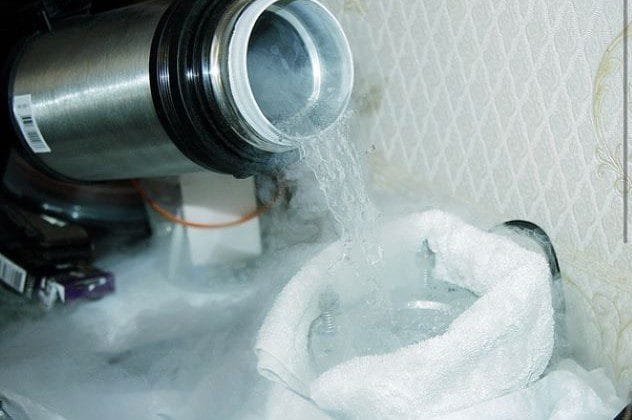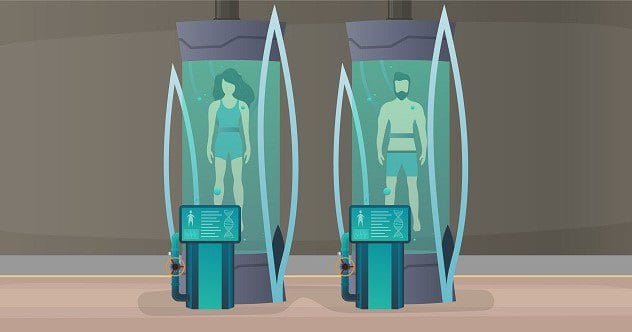When you hear “cryogenics,” what comes to mind? Perhaps you think of far-fetched science fiction tales like Planet of the Apes or Futurama. And no, the famous urban legend about Walt Disney being cryogenically frozen isn’t true. But the real story of cryogenics is just as fascinating!
Cryogenics, derived from Greek words meaning “cold” and “to generate,” is the science of producing ultra-low temperatures. It also involves studying how materials behave when frozen. Over the past two centuries, this field has made incredible leaps. So, let’s delve into ten pivotal early experiments that paved the way for modern cryogenics.
10. Dr. James Arnott’s Groundbreaking Tumor Treatments (1845)
Dr. James Arnott, an English physician active in the mid-19th century, was a pioneer in what we now call cryotherapy. Working at England’s Brighton Infirmary, Arnott first used extreme cold to destroy tissue. As early as 1819, he applied cryotherapy to freeze breast and uterine tumors in cancer patients.
His method involved a potent mixture of “two parts” ice and “one part” sodium chloride, achieving temperatures between -0.4°F and -11.2°F (-18°C and -24°C). Dr. Arnott even designed his own specialized equipment for these procedures. This included a waterproof cushion, flexible tubes for water circulation, a mixture reservoir, and a basin for wastewater. In 1845, he performed what is considered the first cryosurgery. Arnott recognized cryotherapy’s potential not just for cancer, but also as a way to anesthetize skin before surgery. Remarkably, cryotherapy remains a valuable tool in treating various cancers today.
9. The Race to Liquefy Gases: Cailletet and Pictet (1877)

The year 1877 marked a significant breakthrough in cryogenics. Within days of each other, Louis Paul Cailletet and Raoul Pictet independently announced they had successfully liquefied oxygen. Cailletet, who studied in Paris and later worked at his father’s ironworks, began experimenting with high-pressure chemistry in 1869. Pictet announced his achievement to the French Academy, followed closely by Cailletet’s similar claim.
Both scientists understood that cooling and compression were key to liquefying oxygen, but they employed different techniques. Cailletet used a compression apparatus. Pictet, on the other hand, utilized the cascade method, evaporating liquid sulfur dioxide to liquefy carbon dioxide. Pictet’s method produced liquid gas in larger quantities and was more adaptable for other gases. These early experiments were crucial, as liquid hydrogen and helium are now vital in cryogenics.
8. A Cool Idea: Irving S. Cooper’s Cryosurgery Innovation (1961)

Dr. Irving S. Cooper, born in 1922, became a notable neurosurgeon. During the 1950s and 1960s, he helped establish the Neurosurgery Department at St. Barnabas Hospital in New York City and was known for operations aiding patients with movement disorders. Cooper had a peculiar habit of videotaping his surgeries.
In a moment of serendipity on Christmas Day, 1961, Cooper received a wine bottle opener that used carbon dioxide to eject corks. He was fascinated by how a part of the device rapidly cooled a section of the bottle. This observation sparked an idea, and Cooper adapted this bottle-opening technology for surgical use. While patient confidentiality standards were different then, leading some to view his experiments as controversial, Cooper’s ingenuity led to the creation of modern cryosurgery – using intensely cold liquid gases to remove diseased tissue.
7. A Near First: The Attempted Freezing of Wilma Jean McLaughlin (1965)
In 1965, Wilma Jean McLaughlin almost became the first person to be cryogenically frozen. The Life Extension Society had offered to freeze someone free of charge at their temporary facility. McLaughlin passed away on May 20, 1965, from heart and circulatory problems. A team of cryogenic scientists attempted the procedure, but it ultimately failed.
The reasons for the failure are varied and somewhat unclear. Reports cite disagreements among McLaughlin’s relatives and her minister, lack of cooperation from the local doctor and hospital, an unprepared cryogenic capsule, and warnings from the minister about the lack of legal framework. Tragically, McLaughlin was not even aware that her husband had arranged for her to be frozen. Though a failed experiment, this case spurred the Life Extension Society to successfully perform its first human cryo-freezing shortly thereafter.
6. Early Challenges: The 1966 Aborted Cryo-Freezing Experiments
The Cryo-Care Equipment Corporation in Arizona was at the forefront of cryogenic freezing in the early 1960s, utilizing liquid nitrogen. In 1966, they undertook the freezing of a human body that had already been embalmed for two months. The middle-aged woman’s corpse was placed in liquid nitrogen and then stored in a mortuary’s refrigerator at an above-freezing temperature. A year later, she was thawed and buried by her family.
That same year, another attempt to freeze a San Francisco school teacher was aborted. The reason was grim: the man had been deceased for too long. Researchers concluded that even if his brain could one day be revived, it was already damaged beyond any hope of repair. These early attempts highlighted the immense challenges and critical timing involved in cryopreservation.
5. A Milestone: The 1967 Cryo-Freezing of Dr. James Hiram Bedford
Dr. James Hiram Bedford, a University of California-Berkeley psychology professor, made history in 1967. After passing away from kidney cancer, he became the first human to be cryogenically frozen with the hope of future revival. Bedford not only funded his own preservation but also left $100,000 for cryogenic research. His family spent even more defending his will and the freezing process against other relatives.
Doctors preserved Bedford’s body by injecting it with a solution of 15% dimethyl sulfoxide and 85% Ringer’s solution, although it’s thought his brain wasn’t adequately protected from these chemicals. His body was initially stored at Edward Hope’s Crypto-Care facility in Phoenix. Since 1982, Dr. Bedford has been cared for by the Alcor Life Extension Foundation. January 12th, the date of his cryopreservation, is celebrated as “Bedford Day” in the cryogenics community.
4. Cellular Insights: Dr. Peter Mazur’s Hamster Tissue Experiments (1972)
Dr. Peter Mazur was an American researcher who significantly advanced the science of preserving biological material throughcryopreservation. His work in the 1960s and 1970s led to crucial discoveries about what damages cells during the freezing process. Mazur, a Harvard graduate, initially experimented with preserving fungus spores through dehydration.
In his influential 1972 paper, “A Two-Factor Hypothesis of Freezing Injury: Evidence from Chinese Hamster Tissue-Culture Cells,” Mazur identified two main culprits for cellular damage: exposure to high salt concentrations and the formation of ice crystals within the cell. His research was pivotal in determining the optimal cooling rate for different cell types – slow enough to prevent intracellular ice, yet rapid enough to minimize exposure to concentrated solutes. Mazur’s studies laid a critical foundation for advances in cryobiology and cryopreservation techniques.
3. A Young Life Frozen: Genevieve de la Poterie (1972)
The Cryonics Society of New York began freezing patients in the late 1960s, with relatives funding the suspensions and the organization providing storage. In 1972, they froze their first child, eight-year-old Genevieve de la Poterie from Montreal. Genevieve, the daughter of a pharmaceutical salesman and an opera singer, tragically passed away from kidney cancer on January 25, 1972.
Initially, the California-based Life Extension Foundation was supposed to handle the preservation. However, they reportedly did not perform the procedure correctly, leaving little hope for future revival. The Cryonics Society of New York then took over the freezing. Genevieve’s body was stored by the Cryonics Society of California until 1994, but was tragically lost in the “Chatsworth Disaster,” where a vacuum pump failure led to the thawing and destruction of many preserved bodies.
2. Hope for Families: Monash University’s Embryo Cryopreservation (1983)
A landmark achievement occurred in 1983 when the first human embryo was successfully cryopreserved. This pioneering work was conducted by a medical research team at Monash University in Australia. Since then, the cryopreservation of human blood, stem cells, embryos, sperm, and oocytes has resulted in over 300,000 births. The Monash team was tasked with developing methods for human pregnancy via in vitro fertilization (IVF) and embryo freezing.
Their research, which began in 1971, still underpins modern IVF techniques. By 1973, they saw the first promising signs that IVF could treat infertility. In 1983, the program achieved the first IVF births using frozen embryos. This demonstrated that embryos could be frozen, stored, and later implanted into a uterus to develop into a healthy fetus. IVF has since become a widely used treatment for infertility, and Monash IVF is recognized as a leading fertility program in Australia.
1. Man’s Best Friend, Frozen: The Tale of Miles the Dog (1983)
In 1983, a beagle named Miles became a furry participant in a cryonics experiment at the University of California, Berkeley. Named after Woody Allen’s character in the movie Sleeper, Miles had his blood replaced with a glycerol solution. He was then cooled to just a few degrees above freezing. After fifteen minutes in this state of suspended animation, Miles was successfully revived. Researchers presented their findings to the Federation of American Societies for Experimental Biology.
This experiment caused a stir, leading to a significant increase in inquiries to cryonics companies across the United States. At the time, it was hailed as a major step forward in cryogenics. However, a later article in the Los Angeles Times clarified that Miles was not cooled to the extremely low temperatures used for human cryopreservation and that the lead researcher was not a Berkeley medical researcher in the traditional sense. Despite these clarifications, Miles’s temporary journey into the cold captured public imagination.
The early days of cryogenics were filled with bold ideas, dedicated scientists, and experiments that often walked a fine line between breakthrough and controversy. These pioneering efforts, from treating tumors with cold to the dream of cheating death itself, have laid the groundwork for many modern medical and scientific applications. The quest to understand and harness extreme cold continues to evolve, pushing the boundaries of what we believe is possible.
What are your thoughts on these early cryogenics experiments? Which one do you find most fascinating or ethically challenging? Share your views in the comments below!










